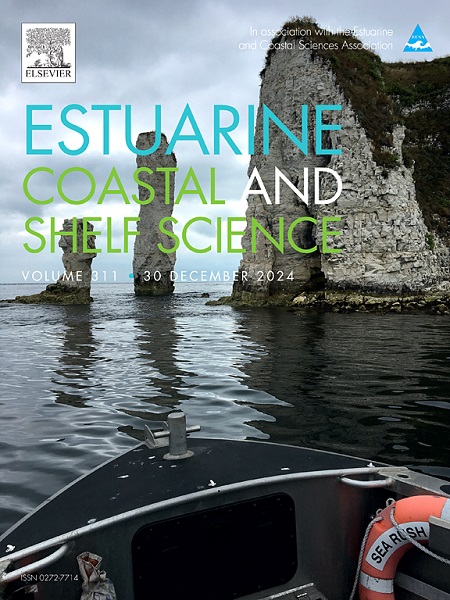多变水文条件下热带沿海泻湖食物网的碳源和氮源
IF 2.6
3区 地球科学
Q1 MARINE & FRESHWATER BIOLOGY
引用次数: 0
摘要
大陆和海洋营养源对沿岸食物网生态功能的影响在温带地区得到了很好的研究,但对热带生态系统,特别是沿岸泻湖的了解仍然较少。在这项研究中,利用碳(δ13C)和氮(δ15N)的稳定同位素追踪了马达加斯加东南部沿海泻湖系统中碳和氮的来源。研究了三个相互连接的沿海泻湖,它们受河流影响和富营养化的程度各不相同。根据泻湖水体条件的空间和季节(雨季和旱季)变化,以及营养物质和有机物的来源,对它们的食物网进行了评估。结果表明,河流输入是 NO3- 的主要来源,雨季的 NO3- 供应量明显较高。相比之下,NH4+ 是泻湖内部产生的,旱季浓度较高。在颗粒有机物(POM,浮游植物的替代物)中观察到的δ13C 值较低,表明陆地-河流碳输入量通常较低。在旱季,泻湖颗粒有机物的δ15N 值特别高,这表明新产生的泻湖水 NH4+ 被吸收,和/或泻湖颗粒有机物池中的 15N 因矿化而富集,导致消费者体内 15N 富集。此外,消费者(鱼类和无脊椎动物)的 δ13C 和 δ15N 值主要反映了泻湖 POM 和沉积有机质(SOM)的值,表明消费者主要依赖泻湖 POM 和 SOM 作为碳源和氮源。消费者的δ15N值进一步表明,一些物种以一个以上的营养级为食,这表明消费者的觅食策略因食物来源的可获得性而灵活。这项研究证明了河流流入量和沉积物在为沿海泻湖食物网提供碳和氮方面的作用,记录了泻湖水文条件的季节性变化对生态的影响。本文章由计算机程序翻译,如有差异,请以英文原文为准。
Carbon and nitrogen sources in tropical coastal lagoon food webs under variable hydrological conditions
Whilst the impact of continental and marine nutrient sources on the ecological functioning of coastal food webs is well investigated in temperate regions, tropical ecosystems remain less well understood, in particular coastal lagoons. In this study, the sources of carbon and nitrogen in a coastal lagoon system in the southeast of Madagascar are traced using stable isotopes of carbon (δ13C) and nitrogen (δ15N). Three interconnected coastal lagoons with different degree of river influence and eutrophication are investigated. Their food webs are assessed with respect to spatial and seasonal (wet and dry seasons) variations in lagoon water conditions, as well as with respect to the sources of nutrients and organic matters. Results show that river input is the main source of NO3−, and that NO3− supply is significantly higher during the wet season. In contrast, NH4+ is produced internally in the lagoon, and concentrations are higher during the dry season. A lower δ13C value observed in particulate organic matter (POM; proxy of phytoplankton) indicates terrestrial-riverine carbon inputs, which generally have low δ13C values. During the dry season, exceptionally high δ15N values of lagoon POM suggest the uptake of newly produced lagoon water NH4+ and/or the 15N enrichment of lagoon POM pool due to mineralization, resulting in 15N enrichment in consumers. Moreover, δ13C and δ15N values of consumers (fishes and invertebrates) reflect predominantly those of lagoon POM and sediment organic matter (SOM), suggesting that consumers primarily depend on lagoon POM and SOM as sources of carbon and nitrogen. The δ15N values in consumers further indicate that some species feed on more than one trophic level, suggesting flexible foraging strategy of consumers as a function of food source availability. This study demonstrates the roles of both river inflow and sediment in supplying carbon and nitrogen to a coastal lagoon food web, documenting the ecological implications of seasonal variations in lagoon hydrological conditions.
求助全文
通过发布文献求助,成功后即可免费获取论文全文。
去求助
来源期刊
CiteScore
5.60
自引率
7.10%
发文量
374
审稿时长
9 months
期刊介绍:
Estuarine, Coastal and Shelf Science is an international multidisciplinary journal devoted to the analysis of saline water phenomena ranging from the outer edge of the continental shelf to the upper limits of the tidal zone. The journal provides a unique forum, unifying the multidisciplinary approaches to the study of the oceanography of estuaries, coastal zones, and continental shelf seas. It features original research papers, review papers and short communications treating such disciplines as zoology, botany, geology, sedimentology, physical oceanography.

 求助内容:
求助内容: 应助结果提醒方式:
应助结果提醒方式:


